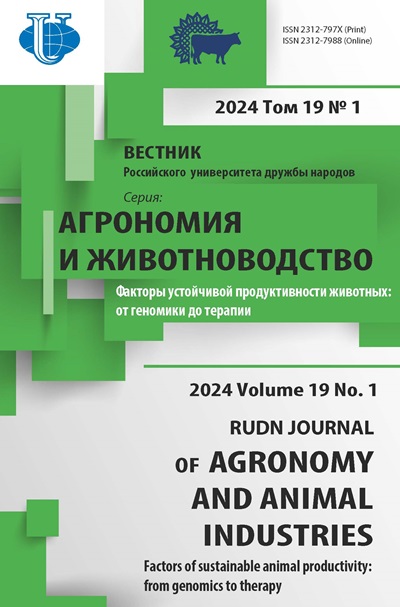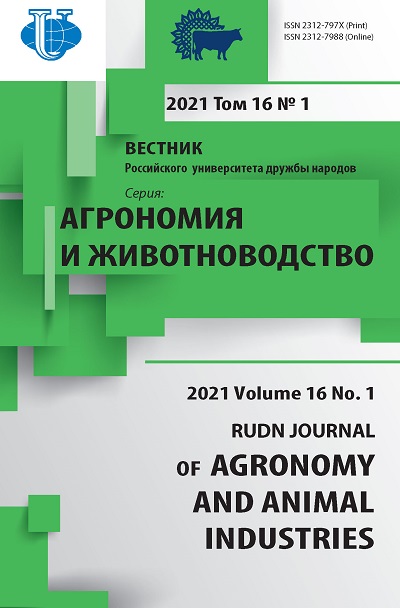Influence of manure application method on gray forest soil fertility, crop yield and quality
- Authors: Meltsaev I.G.1, Esedullaev S.T.1
-
Affiliations:
- Ivanovo Research Institute of Agriculture - branch of Upper Volga Federal Agrarian Research Center
- Issue: Vol 16, No 1 (2021)
- Pages: 86-99
- Section: Soil science and agrochemistry
- URL: https://agrojournal.rudn.ru/agronomy/article/view/19643
- DOI: https://doi.org/10.22363/2312-797X-2021-16-1-86-99
Cite item
Full Text
Abstract
The article presents the results of field experiments on deepening the arable horizon of gray forest medium loamy soil to increase its fertility through applying organic fertilizer under PY-3-35 layer plow to a depth of 25…27 cm. Low mineralization of organic fertilizer during layer cultivation under oxygen deficiency conditions contributed to accumulation of humus in soil by 6.6 t/ha more than during conventional plowing, and by 7.5 t/ha - than during disking. It also improved water-physical and biological properties of soil: number of water-resistant aggregates increased by 4.6 and 5.3 %, soil density lowered by 0.03 and 0.04 g/cm3, number of earthworms increased by 3...6 individuals, expanded reproduction of fertility was provided, productivity of arable land increased by 7.0 and 6.7 % and crop quality increased compared to conventional plowing and disking, respectively. Deep manure incorporation extended life of organic fertilizer up to 5 years, while after conventional plowing and disking this process lasted only 2...3 years. It is not economically and environmentally beneficial, since frequent application requires a lot of fuel, and a large amount of harmful chemical compounds contained in combustion products is dumped into the environment.
Full Text
Table 1. The balance of nutrients in crop rotation (2008—2016)
Fertility element | Units | Manure incorporation method | ||
PN-4-35, 20-22 cm | PYA-3-35, 25-27 cm | BDT-3, 15-18 cm | ||
Nutrient intake from manure, crop-root residues and NPK | ||||
Humus output | t/ha | 13.6 | 13.7 | 13.7 |
Nitrogen | kg/ha | 1069 | 1127 | 1090 |
Phosphorus | kg/ha | 750 | 782 | 781 |
Potassium | kg/ha | 1115 | 1111 | 1110 |
Calcium | kg/ha | 505 | 542 | 504 |
Magnesium | kg/ha | 243 | 246 | 242 |
Crop nutrient removal | ||||
Humus output | t/ha | 9.58 | 9.61 | 9.61 |
Nitrogen | kg/ha | 1012 | 1068 | 1002 |
Phosphorus | kg/ha | 715 | 754 | 716 |
Potassium | kg/ha | 946 | 996 | 947 |
Calcium | kg/ha | 495 | 532 | 495 |
Magnesium | kg/ha | 305 | 323 | 300 |
Soil nutrient balance | ||||
Humus output | t/ha | 4.02 | 4.09 | 4.09 |
Nitrogen | kg/ha | 57.0 | 59 | 88 |
Phosphorus | kg/ha | 35.0 | 28 | 65.0 |
Potassium | kg/ha | 169 | 115 | 16. |
Calcium | kg/ha | 10.0 | 10.0 | 9.0 |
Magnesium | kg/ha | –62.0 | –77.0 | –58.0 |
Table 2. Changes in soil fertility depending on manure application method
No. | Soil parameter | Year | PN433 | PY335 | BDT3 |
1 | Exchange acidity (рНКСl) | 2007 | 6.08 | 6.05 | 6,08 |
2008 | 6.10 | 6.08 | 6,10 | ||
2016 | 6.15 | 6.18 | 6,11 | ||
2 | NNO3, mg/kg | 2007 | 17.3 | 17.4 | 17,1 |
2008 | 17.9 | 18.1 | 18,0 | ||
2016 | 21.7 | 23.6 | 21,9 | ||
3 | P2O5, mg/kg | 2007 | 160 | 161 | 166 |
2008 | 172 | 168 | 174 | ||
2016 | 180 | 210 | 189 | ||
4 | K2O, mg/kg | 2007 | 161 | 160 | 158 |
2008 | 172 | 183 | 176 | ||
2016 | 186 | 208 | 184 | ||
5 | Total absorbed bases, mEq/100 g | 2007 | 18.3 | 18.7 | 18,8 |
2008 | 20.6 | 22.0 | 20,2 | ||
2016 | 23.0 | 25.3 | 21,8 | ||
6 | Humus, % | 2007 | 2.81 | 2.83 | 2,80 |
2008 | 2.84 | 2.87 | 2,85 | ||
2016 | 3.01 | 3.20 | 2,99 | ||
Humus growth, %, (t / ha) | 0,2 (7,8) | 0.37 (14.4) | 0.19 (6.9) | ||
Note. 2007 — leveling crops of oats (source data).
Table 3. Grain yield and quality depending on manure application method (2008—2016)
Variant | Yield, t/ha | Crude protein, % | Gluten,% | Starch, % | Total nitrogen, % | К20, % | Р2О5, % |
|
| Winter wheat after full fallow |
|
| |||
1 | 4.35 | 12.2 | 28.2 | 56.2 | 2.45 | 0.52 | 0.54 |
2 | 4.56 | 13.6 | 31.2 | 59.0 | 2.58 | 0.53 | 0.59 |
3 | 4.36 | 12.3 | 29.4 | 56.3 | 2.41 | 0.52 | 0.54 |
LSD05 | 0.16 |
|
|
|
|
|
|
|
| Winter wheat after perennial grasses |
|
| |||
1 | 4.43 | 14.9 | 36.4 | 54.8 | 2.28 | 0.46 | 0.57 |
2 | 4.59 | 15.4 | 37.6 | 56.3 | 2.31 | 0.50 | 0.60 |
3 | 4.41 | 14.9 | 36.2 | 54.3 | 2.18 | 0.47 | 0.57 |
LSD05 | 0.14 |
|
|
|
|
|
|
|
| Spring wheat |
|
| |||
1 | 3.23 | 14.9 | 36.4 | 54.8 | 2.28 | 0.46 | 0.57 |
2 | 3.58 | 15.4 | 37.6 | 56.3 | 2.31 | 0.50 | 0.60 |
3 | 3.15 | 14.9 | 36.2 | 54.3 | 2.18 | 0.47 | 0.57 |
LSD05 | 0.13 |
|
|
|
|
|
|
|
| Spring barley |
|
| |||
1 | 3.42 | 13.4 | 3.68* | 60.0 | 2.15 | 0.78 | 0.92 |
2 | 3.67 | 14.2 | 3.64 * | 63.0 | 2.23 | 0.95 | 0.94 |
3 | 3.10 | 13.3 | 3.67 * | 59.0 | 2.09 | 0.77 | 0.90 |
LSD05 | 0.15 |
|
|
|
|
|
|
|
| Oats |
|
| |||
1 | 3.85 | 12.8 | 28.2 | 40.1 | 2.37 | 0.67 | 0.55 |
2 | 4.65 | 14.3 | 30.9 | 43.9 | 2.44 | 0.74 | 0.59 |
3 | 4.46 | 13.2 | 29.8 | 42.6 | 2.43 | 0.68 | 0.57 |
LSD05 | 0.14 |
|
|
|
|
|
|
Note. 1— PN-4-35 at 20…22 cm, 100 t/ha; 2 — PY-3-35 at 25…27 cm; 3 — BDT-3 at 15…18 cm; * — fiber content.
About the authors
Ivan Grigoryevich Meltsaev
Ivanovo Research Institute of Agriculture - branch of Upper Volga Federal Agrarian Research Center
Author for correspondence.
Email: ivniicx@mail.ru
Doctor of Agricultural Sciences, Professor, leading researcher, Department of feed production and Agrochemistry
2 Tsentralnaya st., Bogorodskoe village, Ivanovo district, Ivanovo region, 153506, Rusian FederationSabir Tyumenbegovich Esedullaev
Ivanovo Research Institute of Agriculture - branch of Upper Volga Federal Agrarian Research Center
Email: ivniicx@mail.ru
Candidate of Agricultural Sciences, Associate Professor, Director
2 Tsentralnaya st., Bogorodskoe village, Ivanovo district, Ivanovo region, 153506, Rusian FederationReferences
- Verkhovets IA, Malygina NS, Tikhoikina IM, Tuchkova LE, Chuvasheva ES. Influence of gray forest soil fertility on wheat grain yield and quality. Vestnik sel’skogo razvitiya i sotsial’noi politiki [Bulletin of Rural Development and Social Policy]. 2015; 4:22—26. (In Russ).
- Zinyakova NB, Semenov VM. Influence of different fertilizer systems on the content and quality of organic matter in gray forest soil. In: Sistemy ispol’zovaniya organicheskikh udobrenii i vozobnovlyaemykh resursov v landshaftnom zemledelii. T. 1 [Systems for the use of organic fertilizers and renewable resources in landscape agriculture. Vol. 1]. 2013. p. 93—102. (In Russ).
- Okorkov VV, Fenova OA, Okorkova LA. Influence of fertilizers on the content of mobile forms of nitrogen and oat yield on gray forest soils of the Upper Volga region. Agrohimia. 2020; (2):3—13. (In Russ). doi: 10.31857/S0002188120020118
- Okorokov VV, Fenova OA, Okorkova LA. Fertilizers and their impact on productivity and fertility of gray forest soils of the upper Volga region. Vladimir agricolist. 2019; (2):4—11. (In Russ). doi: 10.24411/22252584-2019-10057
- Platonycheva YN, Polyakova NV, Volodina EN. Importance of fertilizers in increasing yield of grain crops and optimizing fertility of gray forest soils. Agrochemical Herald. 2009; (2):24—26. (In Russ).
- Khabirov IK, Khaziev FK, Bagautdinov FY, Ramazanov RY, Gabbasova IM, Agafarova YM. The effect of organic fertilizers on fertility of gray forest soils in Bashkiria. Eurasian Soil Science. 1995; (4):465—471. (In Russ).
- Kotova EO. Prospects of application of sideral agricultural crops as organic fertilizers on gray forest soils of the Central Chernozem zone. In: Noveishie napravleniya razvitiya agrarnoi nauki v rabotakh molodykh uchenykh [The latest trends in the development of agricultural science in the works of young scientists]. Novosobirsk: Zolotoi kolos publ.; 2019. p. 150—154. (In Russ).
- Korchagin AA, Okorkov VV, Okorkova LA, Ragimov AO. Influence of fertilizer systems on humus content and quality in gray forest soils of the Vladimir Opolye. Vladimir agricolist. 2013; (1):6—10. (In Russ).
- Gordon BW, Murphy L, Wiatrak P. Improving phosphorus nutrition of corn. American Journal of Agricultural and Biological Sciences. 2014; 9(3):294—298. doi: 10.3844/ajabssp.2014.294.298
- Shahbazi S, Bagheri H, Farboudi M, Shahrokhi S. The effect of sowing dates and different levels of nitrogen on yield and yield components of second crop corn var. 704-KSC in Miyaneh County. Advances in Bioresearch. 2016; 7(3):119—125. doi: 10.15515/abr.0976-4585.7.3.119125.
- Bausov AM, Borin AA, Nenaidenko GN. Ratsional’noe primenenie udobrenii v usloviyakh rynochnoi ekonomiki [Rational use of fertilizers in a market economy]. Ivanovo; 2007. (In Russ).
- Nenaidenko GN, Mazirov MA. Plodorodie i effektivnoe primenenie udobrenii v agrotsenozakh Verkhnevolzh’ya [Fertility and effective application of fertilizers in agrocenoses of the Upper Volga region]. Vladimir; 2002. (In Russ).
- Kudeyarov VN. Assessment of nutritional degradation of arable soils in Russia. Herald of the Russian Academy of Sciences. 2015; 85(9):771—775. (In Russ). doi: 10.7868/S0869587315090078
- Temnikov VN. Agrochemical ways of increasing the fertility of sod-podzolic soils in the Central region of the NZ of Russia. In: Agrokhimicheskie tekhnologii, priemy i sposoby uvelicheniya ob"emov proizvodstva vysokokachestvennoi s/kh produktsii [Agrochemical technologies, techniques and methods of increasing the volume of production of high-quality agricultural products]. Moscow; 2008. (In Russ).
- Zavalin AA, Blagoveshchenskaya GG. Contribution of leguminous biological nitrogen to the nitrogen budget of Russian agriculture. Eurasian Soil Science. 2012; (6):32—37. (In Russ).
- Meltsaev IG, Zinchenko SI, Esedullaev ST, Loshchinina AE. Sevooborot i sistema obrabotki — osnovy povysheniya plodorodiya pochv i urozhainosti v Verkhnevolzh’e [Crop rotation and processing system-the basis for increasing soil fertility and yield in the Upper Volga region]. Ivanovo: PresSto publ.; 2019. (In Russ).
- Sdobnikov SS. Pakhat’ ili ne pakhat’ [Plow or not plow]. Moscow: Bruks publ.; 1994. (In Russ).
- Zhukov AI, Popov PD. Regulirovanie balansa gumusa v pochve [Regulation of humus balance in soil]. Moscow: Rosagropromizdat publ.; 1988. (In Russ).
- Kostychev PA. Pochvovedenie [Soil Science]. Moscow: Selkhozizdat publ.; 1940. (In Russ).
















